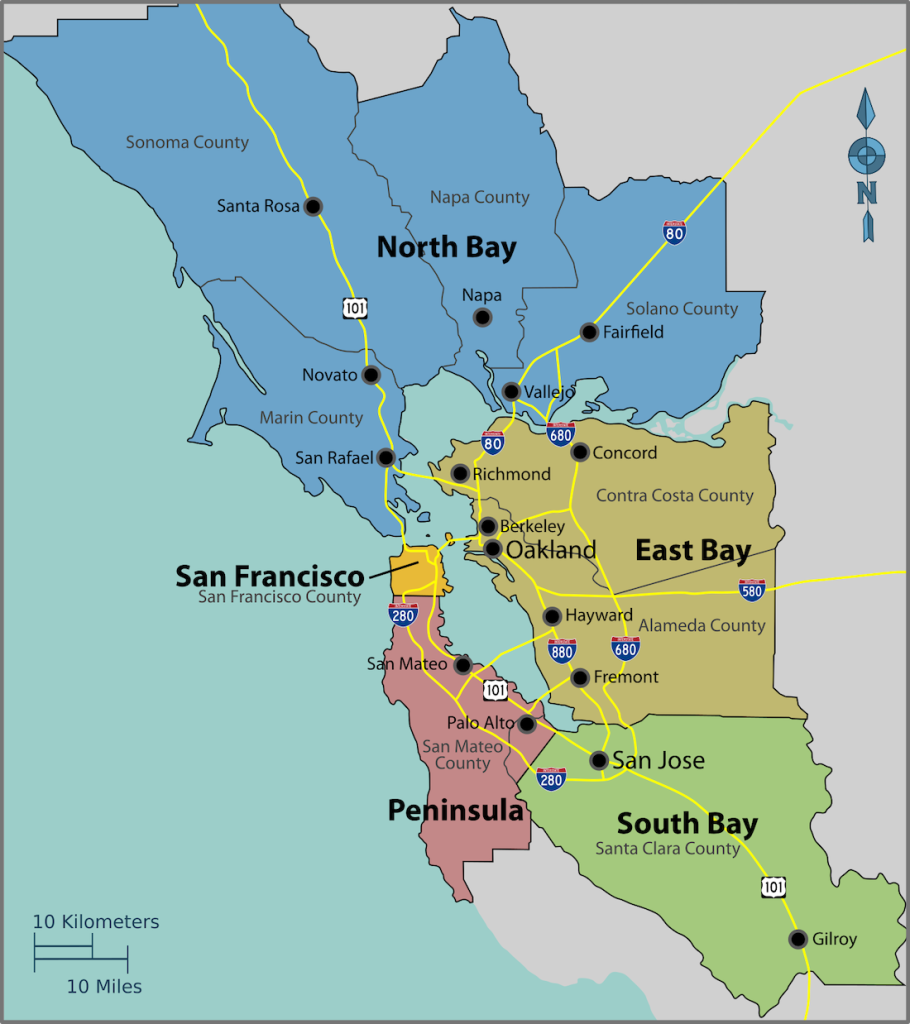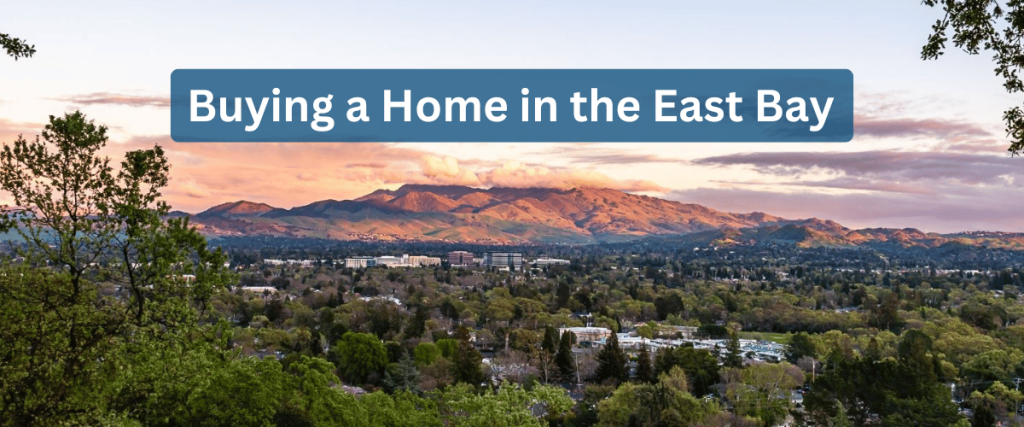Home buyers tend to have a lot of questions about the mortgage underwriting process in…
Buying a Home in the Highly Competitive East Bay Housing Market
The East Bay portion of the San Francisco Bay Area has become one of the most competitive real estate markets in the United States.
It’s easy to understand why. This area offers many benefits, including a moderate climate, strong local economy, and an abundance of natural beauty.
Summary: This guide offers some proven strategies for success when buying a home in the highly competitive East Bay housing market, with updated data and stats for 2025.
Where and What Is the East Bay?
The East Bay includes the cities along the eastern shores of the San Francisco and San Pablo bays. The Suisun Bay marks its northern border, while the Silicon Valley region lies to the south.

The East Bay includes the two counties of Alameda and Contra Costa, which have a combined population of around 2.7 million people. Together, these counties cover a total land area of roughly 1,600 miles. So this is a large and densely populated region of California.
Major Cities Located in the East Bay
There are more than 60 cities located within the East Bay counties of Contra Costa and Alameda. The shoreline area, in particular, is a heavily populated urban corridor with several cities exceeding 100,000 residents.
Here are some of the major cities located within the East Bay region:
- Oakland (population around 400,000): Oakland is the most populous city in Alameda County and third-largest in the broader Bay Area region. It’s a major port city with a thriving cultural scene and diverse neighborhoods.
- Fremont (population over 230,000): Fremont is a family-friendly city known for having excellent schools, diverse neighborhoods, and proximity to major tech companies in Silicon Valley.
- Berkeley (population around 120,000): Home to the renowned University of California, Berkeley, this city is celebrated for its progressive culture, historic architecture, and eclectic dining scene. Check out our Berkeley buyer’s guide.
- Concord (population over 120,000): Located about 30 miles east of San Francisco, Concord offers a historic downtown area and housing options that range from urban condos to detached suburban homes.
- Richmond (population around 110,000): A waterfront city with an industrial history and a growing arts scene. Located along the northeastern shores of the San Francisco Bay, Richmond is considered by some to be an up-and-coming destination in the East Bay. Check out our Richmond buyer’s guide.
- Antioch (population over 110,000): A diverse and affordable city in the East Bay’s northeastern corner, offering a suburban feel with easy access to nature along the Delta shoreline.
- San Leandro (population around 90,000): Positioned between Oakland and Hayward, San Leandro features a mix of residential neighborhoods, commercial districts, and recreational facilities, making it an attractive place to live and work in the East Bay.
What to Know About the Housing Market in 2025
The East Bay housing market is highly competitive in early 2025, as it has been for several years now. A lopsided supply-and-demand situation has home buyers in the area competing fiercely for a limited number of properties.
Here are three more things to know about the East Bay real estate scene in 2025:
1. Low inventory conditions persist in 2025.
One of the first things you might notice as you attempt to buy a home in East Bay is the inventory situation.
Over the past few years, this real estate market has experienced chronically low levels of housing supply. There are plenty of buyers in the market, but not enough properties for sale to meet the demand.
According to a March 2025 housing market update from the California Association of Realtors (C.A.R.), the East Bay counties of Alameda and Contra Costa had very low inventory levels:
- Alameda County had an “unsold inventory Index” of 3 months, lower than the statewide average.
- Contra Costa County had similar numbers, with an unsold inventory index of 3.4 as of March 2025.
The good news is that inventory has risen over the past year or so. Back in March of 2024, these counties both had an unsold inventory index in the 1.5 range. So there’s more supply available these days.
Despite these gains, the East Bay real estate market continues to favor sellers over buyers in 2025, due to a relative shortage of supply.
2. Homes are selling quickly across the East Bay region.
Anyone planning to buy a home in the East Bay in 2025 should be prepared to move quickly. Properties listed for sale in the area have been selling much faster than the national average.
According to the C.A.R. report mentioned above, Alameda and Contra Costa County both had a median “time on market” of only 11 days last month. In contrast, the statewide median time on market was 26 days.
This shows that the East Bay real estate scene is currently moving at a quick pace, with the typical home selling much faster than in other California cities.
Before entering the housing market, buyers should have their financing lined up and a budget in mind. This will allow them to make a quick offer when the right property comes along.
3. Home price growth has slowed down in 2025.
From 2020 to 2025, home prices in the East Bay rose steadily due to a pandemic-fueled surge of home buying activity.
Prices peaked in the summer of 2022, declined for several months after that, and then leveled off through 2024 and into 2025.
According to the March 2025 C.A.R. report mentioned above, the median sale price for both Contra Costa and Alameda counties changed very little over the previous 12 months.
Looking forward, economists expect Bay Area home prices to either rise modestly or remain flat over the next year. This is a big change from just three years ago, when house values were skyrocketing.
This is good news for East Bay home buyers. Slower price growth takes some of the urgency out of the house-hunting process. Buyers can take more time to explore options, without the added concern of fast-rising prices.
Tips for Buying a Home in This Housing Market
If you’re planning to buy a home in the East Bay in the near future, you should know that it’s a highly competitive real estate market. In fact, portions of Alameda and Contra Costa counties are among the most competitive housing markets in the U.S.
Housing market inventory in the East Bay has been tight for years. At the same time, there’s a lot of demand for homes in this area, particularly the coastal cities near the San Francisco Bay’s eastern shore.
When you combine these two factors—strong demand and tight supply conditions—you have end up with a highly competitive real estate market. And that’s exactly what you’ll find when buying a home in the East Bay.
Here are some ways to increase your chance for success when navigating the market:
1. Conduct extensive price research for your target areas.
When it comes to prices, there’s a pretty broad price spectrum across the individual cities and communities in the East Bay. So a bit of advance reconnaissance is warranted.
Fortunately, you can find this kind of information online. Start by looking at websites like Zillow and Realtor.com.
Focus on sale prices rather than list prices. Sale prices will give you better insight into what you can actually afford, based on current market conditions.
2. Look into jumbo mortgage financing.
A conforming loan is a mortgage that meets the guidelines set by government-sponsored entities like Fannie Mae and Freddie Mac. These loans have maximum size limits that can vary based on the county.
A jumbo mortgage loan, on the other hand, exceeds these conforming limits and offers more financing range for expensive markets like the East Bay.
If you’re buying a pricier home in the East Bay, you might need a jumbo loan to finance your purchase. These “oversized” loans often require a higher credit score and a larger down payment.
But if you can check those boxes and have sufficient income, you can probably qualify for a jumbo loan.
Not all properties in the East Bay require jumbo mortgage financing. For example, the median home value within Contra Costa County falls below the conforming loan limit. So it’s possible to use a conforming loan to buy a house in the area.
Just know that a higher level of financing is available if you need it.
3. Understand your negotiating limitations.
In the East Bay, the real estate supply-and-demand situation is skewed in a way that gives sellers more negotiating leverage.
Sellers in Alameda and Contra Costa County can be pretty picky, when it comes to choosing the best offer. That’s because they often receive multiple offers within the first week of listing their homes for sale.
When house hunting in the East Bay, home buyers need to understand this unique dynamic and negotiate accordingly.
4. Make the strongest offer possible.
Make your initial offer as strong as possible by using recent sales data to determine the amount. With other buyers lining up to make offers, you might not get a second chance to present your offer.
Here are some tips for making a strong offer in the Bay Area.
5. Be ready to pounce when the right home comes along.
According to a recent report from the California Association of Realtors, the median “time on market” for the East Bay real estate market was around 11 days. That was lower than the statewide median for the same time period, and much lower than the national median.
This shows that homes tend to sell very quickly within the East Bay real estate market. These statistics send a clear message to home buyers:
If you’re planning to buy a home in the East Bay area, you need to be ready to “pounce” when the right property comes along. This might even mean submitting an offer on the spot, while you’re actually visiting a property.
Need financing? We’ve been located in the East Bay for many years and look forward to helping you buy a home. We offer a variety of mortgage options, including jumbo loans that are well-suited for this market.


